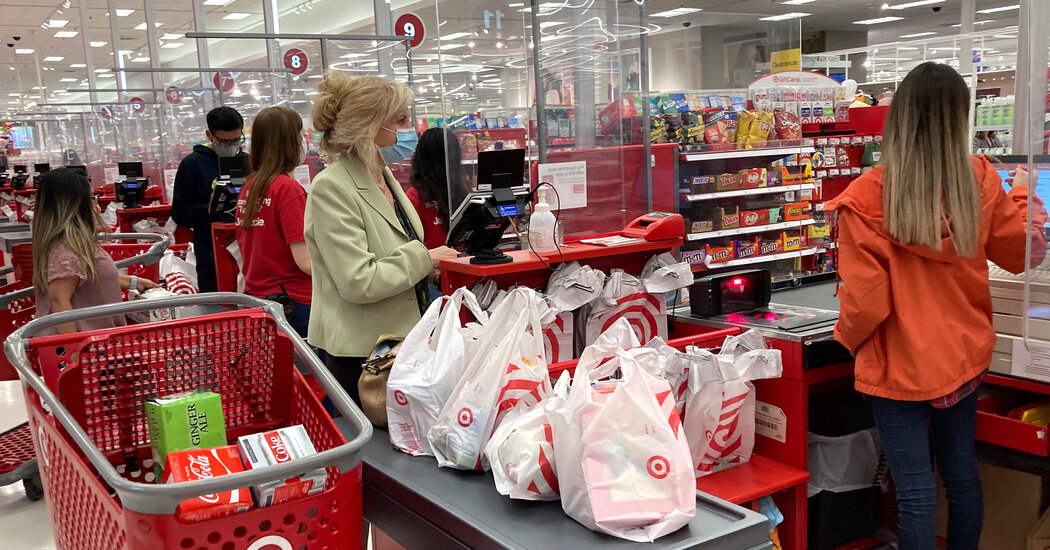
Barbara Sibley’s four New York restaurants had already weathered the city’s initial Covid-19 wave, the prevaccine surge last winter and this summer’s Delta spike when last weekend it finally happened: Fearing an outbreak and struggling with staffing after one of her workers got sick with Covid, she temporarily shut down one of her locations.
That was only the start of Ms. Sibley’s worries. She also had to weigh how long the employee, who was fully vaccinated, should isolate before returning to the job. And the messaging from public health experts was not clear-cut.
In the early days of the pandemic the Centers for Disease Control and Prevention recommended that most people who tested positive for the coronavirus isolate for 14 days. It later reduced its recommended isolation period to 10 days. But these policies were based on data from unvaccinated individuals and were implemented before the widespread availability of rapid tests. An increasing number of health and policy professionals now suggest that vaccinated people can end their isolation after five to seven days, so long as they are not symptomatic and they test negative.
On Thursday, the C.D.C. reduced, in some circumstances, the number of days it recommends that health care workers who test positive for the coronavirus isolate themselves, but it did not address other businesses.
“Every expert has been calling for shorter isolation times, so it’s a good move, but it’s shortsighted not to apply this more broadly: schools, colleges, sports, Broadway, restaurants, airlines,” said Joseph Allen, an associate professor at the T.H. Chan School of Public Health at Harvard University. “All are facing this same problem with having to isolate people for extended periods without the option to ‘test to return.’”
The C.D.C. said Thursday that it “continues to evaluate isolation and quarantine recommendations for the broader population” as it learns about the Omicron variant of the coronavirus and “will update the public as appropriate.”
In New York, Gov. Kathy Hochul said on Friday that fully vaccinated critical workers could return to work five days after testing positive, so long as they have no symptoms or their symptoms are resolving and they have had no fever for 72 hours. Those workers will also have to wear a mask, she said.
Omicron has intensified staffing shortages across industries, and the spike in cases has disrupted travel during the holidays, stranding thousands of customers and underscoring the economic toll of employees needing to isolate. Already, some economists are warning about the potential impact that shutdowns can have on consumer spending.
Delta Air Lines asked the C.D.C. on Tuesday to cut isolation time to five days for fully vaccinated people, warning that the current 10-day period may “significantly impact” operations. It was followed by JetBlue and Airlines for America, a trade group that represents eight airlines.
But the Association of Flight Attendants pushed back on that request, telling the C.D.C. on Thursday that “we support your agency’s current recommendation to isolate for 10 days” and that decisions to reduce isolation times “should be made by public health professionals, not airlines.”
Sara Nelson, the international president of the union, said flight attendants should not have to return to work until they were healthy — and tested negative. “We do not see the justification for reducing the number of days at this time,” she wrote in a letter to the C.D.C.’s director.
Uncertainty around isolation guidelines has added to the angst that many employers are feeling.
“It’s stressful because you have the responsibility to keep your guests safe, your staff and your family,” Ms. Sibley said. While some companies are asking employees who test positive to isolate for 14 days, she also wants to do what makes sense for her workers.
“You can do 14 days if you’re not trying to make sure 150 people survive and pay rent through your business,” she said.
With scientific understanding of the coronavirus moving more quickly than public health guidelines, and with much still unknown about the Omicron variant, some business owners feel forced into playing epidemiologist.
“If I were an employer I would not go outside C.D.C. recommendations,” said Dr. Megan Ranney, an emergency physician and an associate dean at the School of Public Health at Brown University. “That’s why we need the C.D.C. to update its recommendations, if they think the science supports it.”
Requirements for longer isolation periods could also create disincentives for people to get tested, according to Dr. Ashish Jha, dean of Brown’s School of Public Health. “There are going to be a lot of people who are, if they have mild symptoms, are going to not test or not report because it’s really substantial to be out for 10 days,” he said.
Diana Mora, the owner of Friends and Lovers, a bar in Brooklyn with just over a dozen employees, said trying to follow public health guidelines while keeping her business running was a constant source of worry.
“We’re so small we don’t really have enough staff to tell everyone to stay home,” she said, though the bar has been following the C.D.C.’s 10-day guideline. “If there’s more than two people who are exposed and have to isolate, we’re stuck in a lurch.”
Managing the budget is also a concern. “Luckily for us we’re able to continue to pay people, but as this continues it gets tricky,” Ms. Mora said.
In industries where employees can work remotely, like technology, companies seem to feel little need to move faster than the C.D.C. Even employers that need large numbers of workers on site, like Target, Kroger and DoorDash, say they continue to follow the agency’s recommendations.
The National Football League now allows vaccinated players who test positive to come back the next day provided they test negative twice. It also eliminated weekly testing for vaccinated players who are asymptomatic, with its chief medical officer saying the pandemic had reached a stage in which it’s unnecessary for vaccinated players to sit out if they feel healthy.
Calls to reduce the isolation period could grow if infections spike as expected through the holidays. Already, Broadway shows have canceled performances through Christmas. CityMD, the privately owned urgent care clinic, temporarily shut 19 sites in New York and New Jersey because of staffing shortages. At least a dozen New York restaurants have temporarily closed in response to positive tests.
“I think lots of companies are looking at a lot of disruption in the next month and trying to put in policies right now, because they know their employees are going to get infected in very high numbers,” said Dr. Jha.
The United States might take direction from policy shifts abroad. Britain said on Wednesday that it was reducing to seven from 10 the days that people must isolate after showing Covid-19 symptoms.
After the British government lifted nearly all its pandemic restrictions in July, hundreds of thousands of workers were pinged by the National Health Service’s track-and-trace app and told to isolate because they had been exposed to the coronavirus. Businesses complained of being short-staffed, and economists said the “pingdemic” may have slowed economic growth in July.
In the United States, new tools to help manage through the pandemic are on the way.
The Food and Drug Administration this week authorized two pills to treat Covid, from Pfizer and Merck. Those treatments have been shown to stave off severe disease and have potential to reduce transmission of the virus, though supply of both pills, especially Pfizer’s, will be limited in the next few months.
President Biden said on Tuesday that he planned to invoke the Defense Production Act to buy and give away 500 million rapid antigen tests, a crucial tool in detecting transmissibility, though those tests will not be available for weeks or longer.
If a combination of the antiviral pills and rapid tests is able to get individuals back to work faster, “that’s a big economic point,” said Dr. Eric Topol, a professor of molecular medicine at Scripps Research.
Still, some employers are proceeding with caution. Molly Moon Neitzel, who owns an ice cream business in Seattle with just over 100 employees, said she had kept guidelines for isolation conservative.
“I’m on the side of protecting people over getting them back to work right now,” she said, adding that if it were summer and her business were busier, she might consider a shorter isolation period. “It’s the slowest time of the year for an ice cream company, so that is in my favor.”
Some public health experts worry that if the C.D.C. shortens its guidelines on isolating, employers could pressure workers to get back before they’re fully recovered.
“What I don’t want to see happen is for this to be used as an excuse to force people to come back while they are unwell,” Dr. Ranney of Brown said.
And even with clearer guidelines, putting policies in place can be tricky. While some experts suggest different isolation rules for vaccinated and unvaccinated employees, some companies do not yet have a system for tracking which of their workers have gotten a vaccine. The question of whether the C.D.C. will change its definition of fully vaccinated to include booster shots adds another layer of complexity.
It’s not just sick employees who may have to stay home: Companies are also grappling with whether vaccinated workers should quarantine after exposure to someone with Covid-19, which C.D.C. guidelines do not require.
“It becomes a challenge for employers to choose between providing a safer environment and keeping staff intact, or going with the C.D.C. guidance,” said Karen Burke, an adviser at the Society for Human Resource Management.
But almost two years into the pandemic, that’s the position that employers continue to find themselves in, amid an ever-flowing cascade of new data, guidelines and considerations.
“Every moment, you’re making life or death decisions,” Ms. Sibley said. “That’s not what we signed up for.”
Rebecca Robbins contributed reporting.







